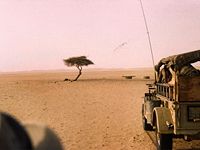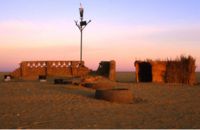
Arbre du Ténéré
Encyclopedia

English language
English is a West Germanic language that arose in the Anglo-Saxon kingdoms of England and spread into what was to become south-east Scotland under the influence of the Anglian medieval kingdom of Northumbria...
as the Tree of Ténéré, was a solitary acacia
Acacia
Acacia is a genus of shrubs and trees belonging to the subfamily Mimosoideae of the family Fabaceae, first described in Africa by the Swedish botanist Carl Linnaeus in 1773. Many non-Australian species tend to be thorny, whereas the majority of Australian acacias are not...
, of either Acacia raddiana or Acacia tortilis
Acacia tortilis
Acacia tortilis, the Umbrella Thorn Acacia, also known as Umbrella Thorn and Israeli Babool, is a medium to large canopied tree native primarily to the savanna and Sahel of Africa , but also occurring in the Middle East....
, that was once considered the most isolated tree
Tree
A tree is a perennial woody plant. It is most often defined as a woody plant that has many secondary branches supported clear of the ground on a single main stem or trunk with clear apical dominance. A minimum height specification at maturity is cited by some authors, varying from 3 m to...
on Earth — the only one for over 400 kilometres (248.5 mi). It was a landmark on caravan
Camel train
A camel train is a series of camels carrying goods or passengers in a group as part of a regular or semi-regular service between two points. Although they rarely travelled faster than the walking speed of a man, camels' ability to handle harsh conditions made camel trains a vital part of...
routes through the Ténéré
Ténéré
The Ténéré is a desert region in the south central Sahara. It comprises a vast plain of sand stretching from northeastern Niger into western Chad, occupying an area of over...
region of the Sahara
Sahara
The Sahara is the world's second largest desert, after Antarctica. At over , it covers most of Northern Africa, making it almost as large as Europe or the United States. The Sahara stretches from the Red Sea, including parts of the Mediterranean coasts, to the outskirts of the Atlantic Ocean...
in northeast Niger
Niger
Niger , officially named the Republic of Niger, is a landlocked country in Western Africa, named after the Niger River. It borders Nigeria and Benin to the south, Burkina Faso and Mali to the west, Algeria and Libya to the north and Chad to the east...
— so well known that it and the Arbre Perdu or 'Lost Tree' to the north are the only trees to be shown on a map at a scale
Scale (map)
The scale of a map is defined as the ratio of a distance on the map to the corresponding distance on the ground.If the region of the map is small enough for the curvature of the Earth to be neglected, then the scale may be taken as a constant ratio over the whole map....
of 1:4,000,000. The Tree of Ténéré was located near a 40-metre (131 feet)-deep well. It was knocked down by a drunk truck driver in 1973.
Background
The Tree of Ténéré was the last of a group of trees that grew when the desertDesert
A desert is a landscape or region that receives an extremely low amount of precipitation, less than enough to support growth of most plants. Most deserts have an average annual precipitation of less than...
was less parched than it is today. The tree had stood alone for decades. During the winter of 1938–1939 a well was dug near the tree and it was found that the roots of the tree reached the water table
Water table
The water table is the level at which the submarine pressure is far from atmospheric pressure. It may be conveniently visualized as the 'surface' of the subsurface materials that are saturated with groundwater in a given vicinity. However, saturated conditions may extend above the water table as...
33–36 meters (108 to 118 feet) below the surface.
Commander of the A.M.M., Michel Lesourd, of the [Central service of Saharan affairs], saw the tree on May 21, 1939:
In his book , French
French people
The French are a nation that share a common French culture and speak the French language as a mother tongue. Historically, the French population are descended from peoples of Celtic, Latin and Germanic origin, and are today a mixture of several ethnic groups...
ethnologist and explorer Henri Lhote
Henri Lhote
Henri Lhote was a French author, explorer, ethnographer, and "expert on prehistoric cave art" who described and is credited for the discovery of "important cave paintings" in an "assembly of 800 or more magnificent works of primitive art...in a virtually inaccessible region on the edge of the...
described his two journeys to the Tree of Ténéré. His first visit was in 1934 on the occasion of the first automobile
Automobile
An automobile, autocar, motor car or car is a wheeled motor vehicle used for transporting passengers, which also carries its own engine or motor...
crossing between Djanet
Djanet
Djanet is an oasis city in southeast Algeria. It is located in Illizi Province, 412 kilometers from Illizi. It is inhabited by the Kel Ajjer Tuareg people. It is the capital of Djanet District.-Transport:...
and Agadez
Agadez
-Sources:* Aboubacar Adamou. "Agadez et sa région. Contribution à l'étude du Sahel et du Sahara nigériens", Études nigériennes, n°44, , 358 p.* Julien Brachet. Migrations transsahariennes. Vers un désert cosmopolite et morcelé . Paris: Le Croquant, , 324 p. ISBN : 978-2-91496865-2.*. Saudi Aaramco...
. He describes the tree as "an Acacia with a degenerative trunk, sick or ill in aspect. Nevertheless, the tree has nice green leaves, and some yellow flowers". He visited it again 25 years later, on 26 November 1959 with the Berliet
Berliet
Berliet was a French manufacturer of automobiles, buses, trucks and other utility vehicles, based in Vénissieux, outside of Lyon, France.-Early history:...
-Ténéré mission, but found that it had been badly damaged after a vehicle had collided with it:
Death and replacement

Niamey
-Population:While Niamey's population has grown steadily since independence, the droughts of the early 1970s and 1980s, along with the economic crisis of the early 1980s, have propelled an exodus of rural inhabitants to Niger's largest city...
.
It has since been replaced by a simple metal sculpture representing the tree.

